IMOCA crews face a big early decision as they take on the longest leg in the history of The Ocean Race
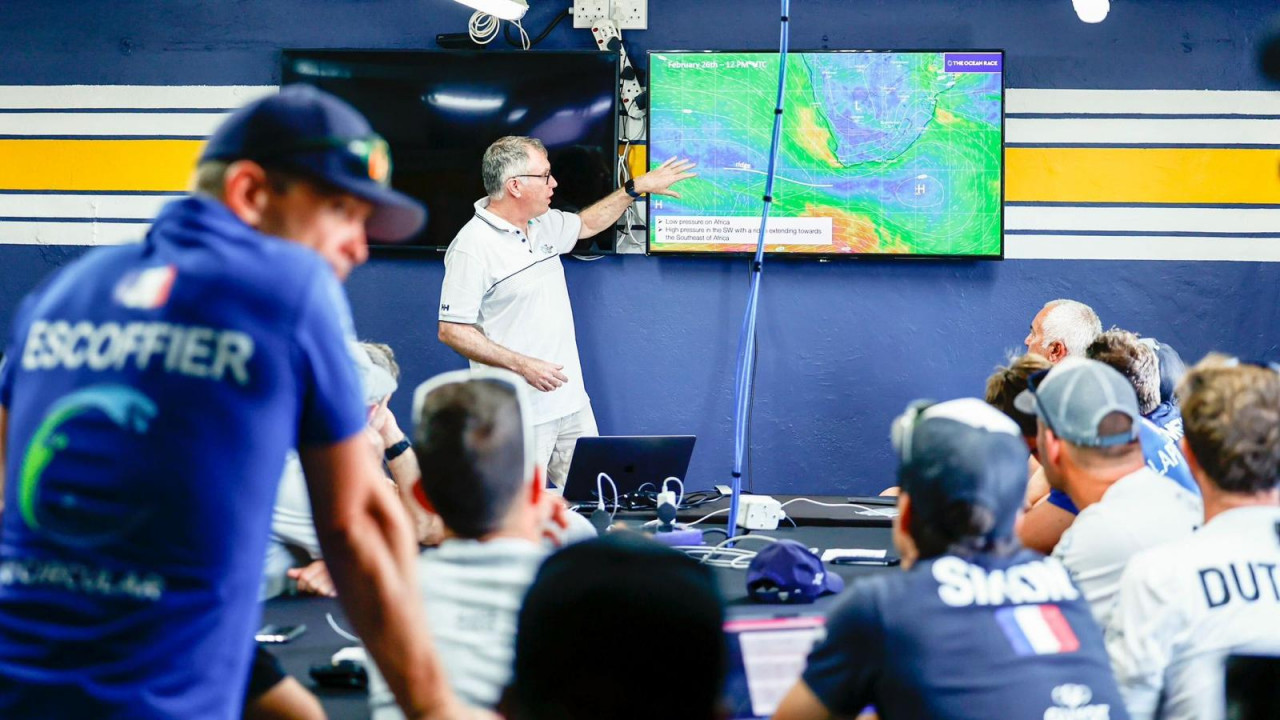
The longest stage in the 50-year history of The Ocean Race – 12,750 nautical miles from Cape Town in South Africa to Itajai in Brazil – starts today (SUN) with a big decision for navigators and skippers.
The key question is whether to stay close to the shore going past the Cape of Good Hope, or head further south – or even southwest – in the hunt for bigger breeze and the first of the westerlies that will take the five IMOCAs east towards Australia.
Christian Dumard, the official weather consultant for The Ocean Race, says if one crew decides to head south, the others may well follow suit for fear of missing a trick. He says the leg will start with strong upwind conditions on Sunday evening, then there is the possibility of a split.
“The boats could go upwind and go quite close to the Cape of Good Hope, but some could reach off to the southwest and go and get the windshift (south-east to southwest) in the high pressure system. They will not like having a negative VMG, but if one or two boats go southwest, the others could follow,” said Dumard.
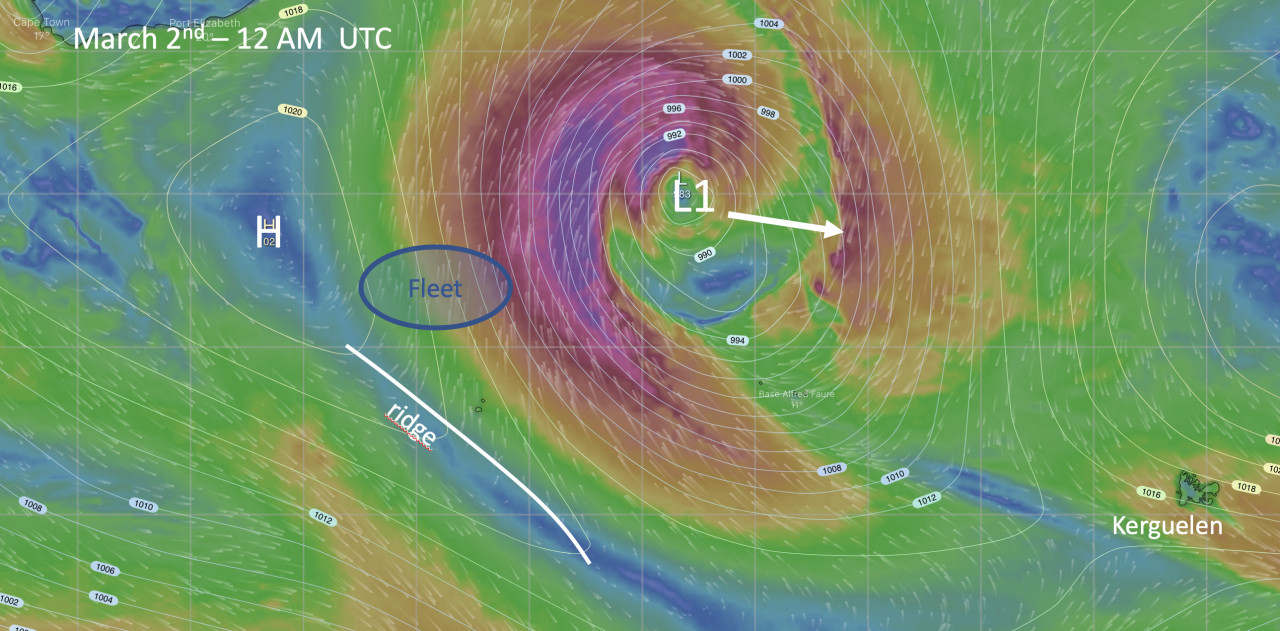
The fleet will be sailing between the high pressure system in their West and the low pressure system ahead of them.
Weather forecast, Sunday 26 February, 14:00 UTC
There is an interesting precedent for this deep in the history of The Ocean Race back in 1997, when the Whitbread 60, Swedish Match, skippered by Gunnar Krantz, split from the fleet after leaving Table Bay and headed offshore alone. The move produced a 35-mile lead over the chasing pack by midnight on the first day and an eventual leg victory at Fremantle in Australia 15 days later.
Dumard says the early stages of this epic modern-day stage to Cape Horn and then Brazil, will be all about getting south and into the westerly winds that howl around the bottom of the globe through the Southern Ocean, offering super-fast but hugely uncomfortable surfing conditions for the IMOCA crews.
“If we look in the longer term, there is a low pressure system on 2 and 3 of March,” explained Dumard. “The position of this low pressure, and how deep it will be, still varies quite a bit, depending on the models. For now, the idea is to get south and into the westerlies as soon as possible. If the low moves further south than expected, then there could be other options to go north of the low – for me, it looks more likely to be the southern option, but the game is still open and it could still change.”
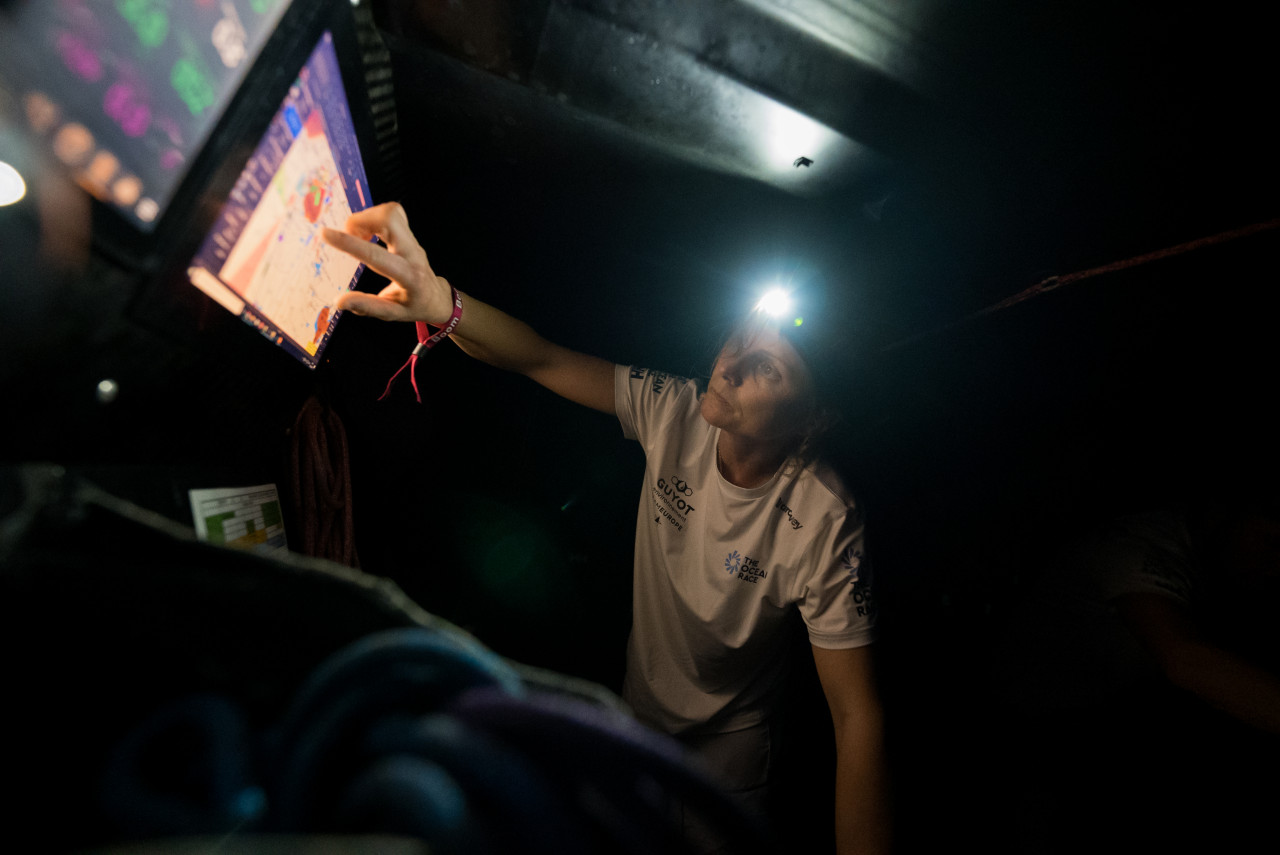
The leg overall is likely to see a mix of conditions, with areas of light winds spreading south across the racetrack, but also storms which could be violent, as Dumard warns. “It is the cyclone season in the Indian and Pacific Oceans, so we have had a lot of tropical storms recently and, when they are in phase with a frontal system – when they are caught in a front of a low pressure system – then they can become very active again.”
But while this leg will be dominated by big winds in the “South,” the podium order may well be settled by what happens after Cape Horn, not before it. Dumard says this is going to be a challenging part of the race, as the crews cross weather systems, with numerous of transitions to get right.
“It’s probably the most difficult part of the leg,” he said. “We talk about the Southern Ocean which is not easy, but then you have low pressure systems coming from Brazil, and high pressure coming quickly behind them, and the boats are not moving with the systems but across them, so conditions change very quickly.”
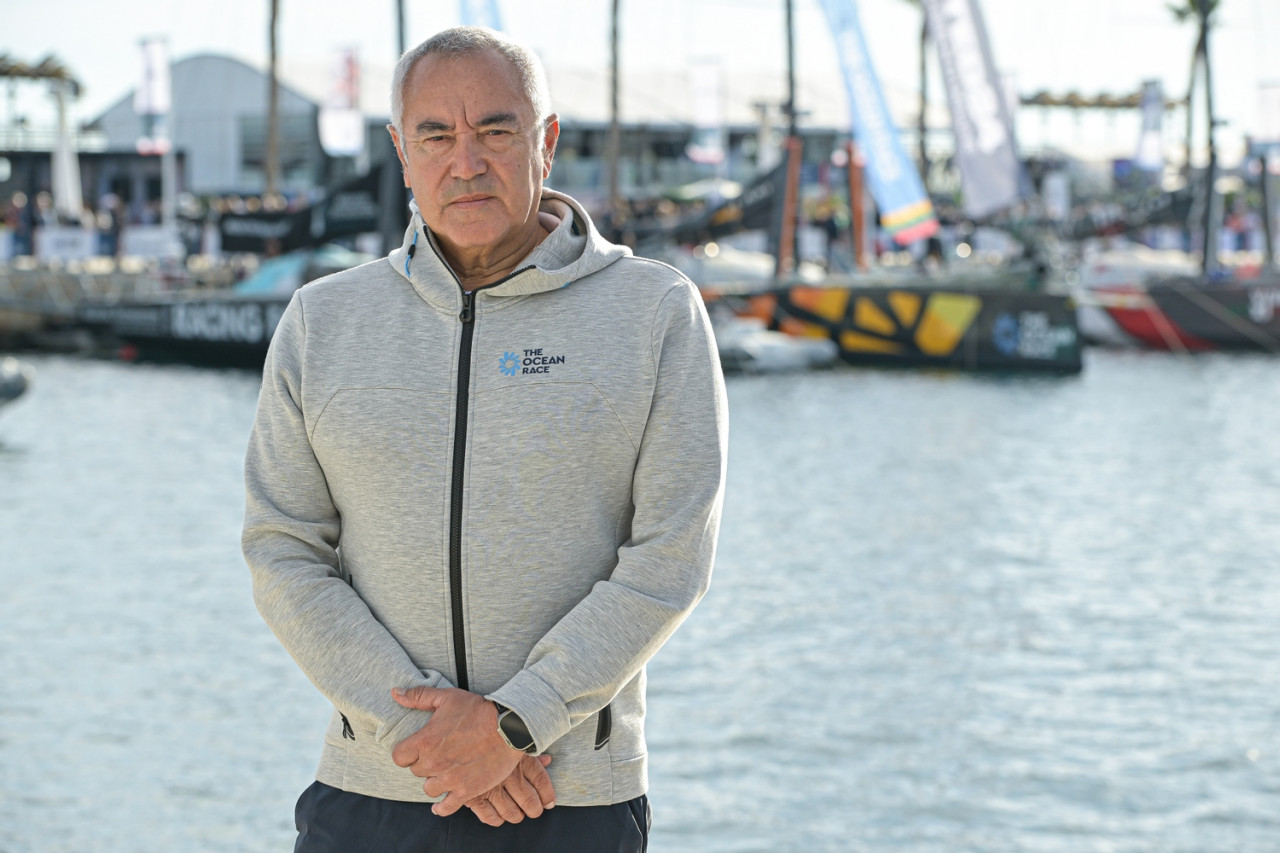
Then the final hours into Itajai could be a lottery. “At Itajaì, you can have light winds, thunderstorms, rain squalls, anything can happen on the way to the finish,” summarised Dumard.
Race director Phil Lawrence, meanwhile, is keeping an eye on iceberg activity and encroachments of colder water onto the course. The leg features a constant ice exclusion zone, designed to keep the crews away from bergs and smaller chunks of ice that could badly damage an IMOCA travelling at high speed.
Lawrence says the northern limit of the zone will be under review, especially in the eastern Pacific on the way towards Cape Horn. “Whilst the leg is running, we will be carrying out further scans of the Pacific, and it is highly likely that we will make adjustments to the ice limit as necessary,” he said. “Either moving it up, if we identify risk, or moving it down if we see that it is safe. At the moment, there is an unusual situation in the eastern Pacific, where there is a lot of ice activity quite far north, so our present limit has got quite a bulge in its profile. But we will do some more scans and maybe we can bring it further south in the weeks to come.”
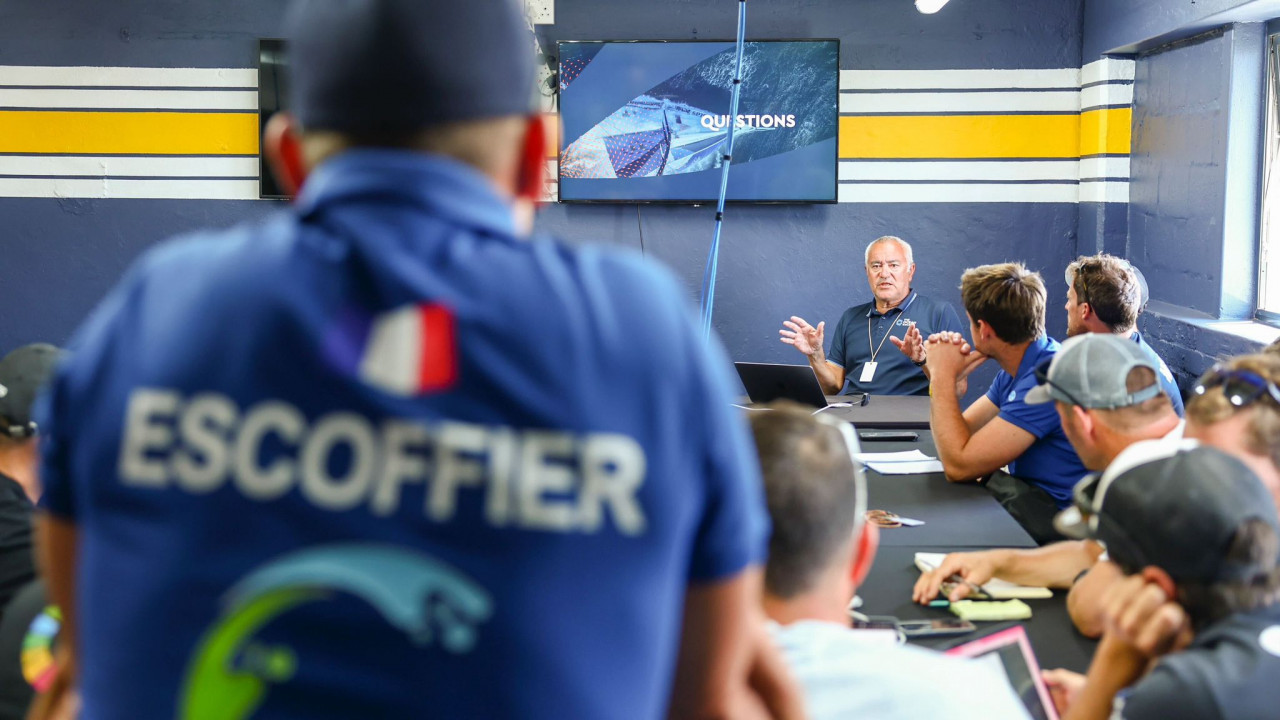
Lawrence says The Ocean Race HQ team was impressed by the generally good condition of the boats when they arrived at Cape Town at the end of Leg 2. He is well aware, however, that this leg could produce unwelcome setbacks for boats suffering damage in big seas. “On every leg of the course, we have a big contingency plan, not just on the Southern Ocean leg,”he explained. “So we have already pre-planned the leg with all the marine rescue co-ordination centres, and we have identified ports of refuge all along the route where boats could go in the event they need to divert.”
One factor that the crews will be wary of in the early stages of this leg, is the danger of hitting debris in the water south of the Cape of Good Hope, an area of ocean that has been a source of problems for IMOCAs in the past and Jules Verne crews too. In this race Lawrence says a protocol is in place to ensure that if any crews either hit or encounter debris in the water, they will notify Race HQ immediately so the details can be quickly shared with the rest of the fleet.
Ed Gorman
IMOCA LEG 3 CREW LIST
11TH HOUR RACING TEAM
Charlie ENRIGHT (USA) - skipper
Simon FISHER (GBR)
Justine METTRAUX (SUI)
Jack BOUTELL (GBR/AUS)
Amory ROSS (USA) - OBR
BIOTHERM
Paul MEILHAT (FRA) - skipper
Anthony MARCHAND (FRA)
Sam DAVIES (GBR)
Damien SEGUIN (FRA)
Ronan GLADU (FRA) - OBR
TEAM HOLCIM-PRB
Kevin ESCOFFIER - skipper
Sam GOODCHILD (GBR)
Abby EHLER (GBR)
Tom LAPERCHE (FRA)
Julien CHAMPOLION (FRA) - OBR
GUYOT ENVIRONNEMENT-TEAM EUROPE
Benjamin DUTREUX (FRA) - skipper
Robert STANJEK (GER)
Annie LUSH (GBR)
Sébastien SIMON (FRA)
Charles DRAPEAU (FRA) - OBR
TEAM MALIZIA
Boris HERRMANN (GER) - skipper
Will HARRIS (GBR)
Rosalin KUIPER (NED)
Nicolas LUNVEN (FRA)
Antoine AURIOL (FRA) - OBR
Teams info
After a stunning 2025 season Sam Goodchild is the IMOCA Globe Series Champion for the second time
After a long season at the top of the IMOCA fleet that featured three race wins, Great Britain’s Sam Goodchild is for the second time in three years the IMOCA Globe Series Champion.
•••Quel rôle peut jouer la course au large dans la transformation du transport international ? Avec Pie…
Pour ce 10ᵉ épisode de Transitions, enregistré au Havre lors du départ de la Transat Café L'Or, nous recevons Jeremy Pochman, PDG de 11th Hour Racing, et Pierre-Antoine Morvan, responsable du pôle course au large et supe…
•••